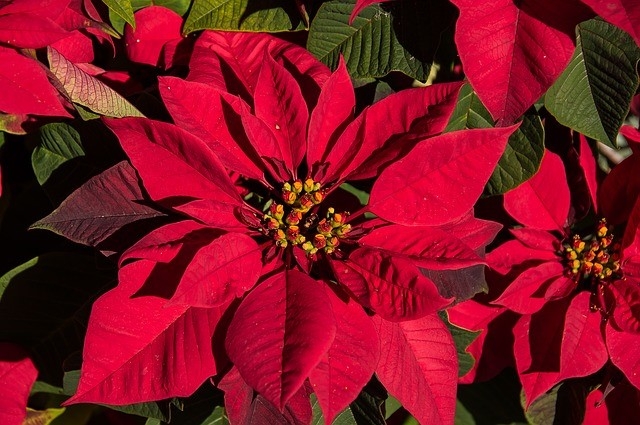
The actual flower of the poinsettia is the yellow center cluster (cyanthia). The colorful bracts which are modified leaves attract insects to the flowers and will drop after pollination. For this reason, when selecting a plant choose one with little or no yellow pollen showing.
Poinsettias bloom when the days get shorter. The coloring of the bracts is achieved through photoperiodism. This requires a period of darkness to change color. Once completing this process, they then require an abundance of daylight to attain a bright color.
Contrary to myths, poinsettias are not poisonous to humans, however, the sap may cause dermatitis (poison control article). They are toxic to dogs, cats and horses causing irritation to the mouth and stomach, sometimes causing vomiting (according to aspca.org)
Let us look at the general care requirements:
Temperature and Light Requirements
Poinsettias (Euphorbiaceae pulcherrima) is native to Mexico. The poinsettia is a perennial shrub and will grow 10-15 feet in Mexico. They are suitable to Sunset Zones 13, 16-24; H1, H2; or indoors (link to determine your Western Sunset Zone). Ideal temperature is 65-70° F. When exposed to temperatures below 50° F, the poinsettia will suffer damage. These beauties are extremely sensitive to frost and will die.
Poinsettias make a great houseplant if they receive adequate light and cultural care. For indoors, place where the plant will receive bright daylight, possibly a south, east or west window. Avoid placing in drafts, heat ducts, fireplaces, and heaters. Never place on top of appliances.
Watering and Fertilizing
Water only when dry and do not overwater. Water when the soil surface feels dry to the touch. A pot that is light when you lift it is another indication of dry soil. Do not allow the plant to wilt before watering, as this will stress the plant.
Avoid allowing the plant to stand in water as the plant's roots will rot. Remove the foil or outer pot before watering. Sit the plant in a sink and water thoroughly. Allow to drain completely before removing from sink.
Your plant does not require feeding during the holidays. Refer to the schedule below. Select a water-soluble all-purpose houseplant fertilizer. Mix ¼ - full strength (depends on timing see below), feeding monthly to provide nutrients during their growth period.
Pest Management
When watering, always check for pests. It is always best to deal with pests when you first notice them and not allow it to get out of hand. (Link which provides various resources for houseplant care)
Re-potting
The ideal time to repot or transplant is late spring or early summer. Choose a container that is 2-4 inches larger than the original pot. Make sure the container provides good drainage. Use a sterile potting mix with a good amount of organic matter. Water well after repotting and allow to drain.
Reblooming Instructions
I personally have not given this a try, but for those of you who are willing to give it a go and invest the necessary time, I have found the following calendar of care information from Dr. Leonard Perry, Extension professor emeritus at the University of Vermont, who developed Caring for your Poinsettia Year-Round. Dr. Perry states “There is no guarantee that your poinsettia will bloom again next December, even with year-round care. But if you'd like to try, there are a few tips”:
New Year's Day – Fertilize with an all-purpose houseplant fertilizer at the recommended rate. Continuing to provide adequate light and water which will prolong the bloom for several weeks.
Valentine's Day – Check for insects and manage if you find them. White fly is a common insect. If the plant has become leggy, now is the time to trim it back to about 5 inches tall. Pruning will promote a more compact growth.
St. Patrick's Day – Prune to remove dried and faded parts of the plant. Remove leaves which have dropped to the soil. Continue to keep inside at a bright sunny window. Check soil level, add more soil if needed, using commercially available sterile soil mix.
Memorial Day – Trim off branches a couple of inches to promote side branching. Locate an outward facing node and cut above node. Repot to a larger container (2-4 inches larger) using a sterile growing mix.
Father's Day – If outside temperatures are above 50° F, set plant outside for the summer in indirect light.
Fourth of July – Trim again. Move to full sun. Continue to fertilize and water.
Labor Day – Move back indoors place where it will get at least six hours of direct light daily. As new growth begins, reduce fertilizer to one-quarter the recommended strength.
Fall equinox (approximately September 21st) - give the plant 16 hours of uninterrupted darkness and 8 hours of bright light every day. Note: this is critical, during the 16 hours for the plant cannot receive any light.Maintain night temperatures in the low 60° F range. Continue to water and fertilize (at ¼ strength). During the 8 hours of bright light-rotate to give all sides even light.
Thanksgiving – Discontinue the short day/long night regiment. Place plant in a sunny window that will get at least 6 hours of bright direct light. Reduce water and fertilizer.
Christmas – Enjoy your “new” poinsettia. Start the cycle all over again after the new year.